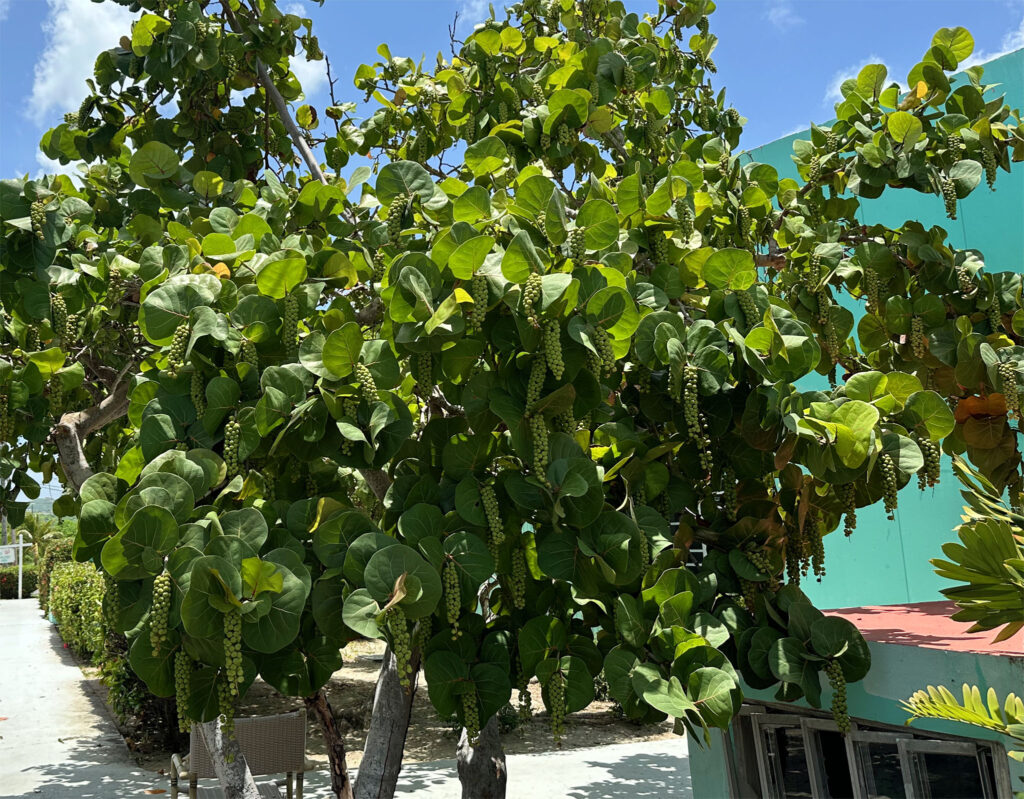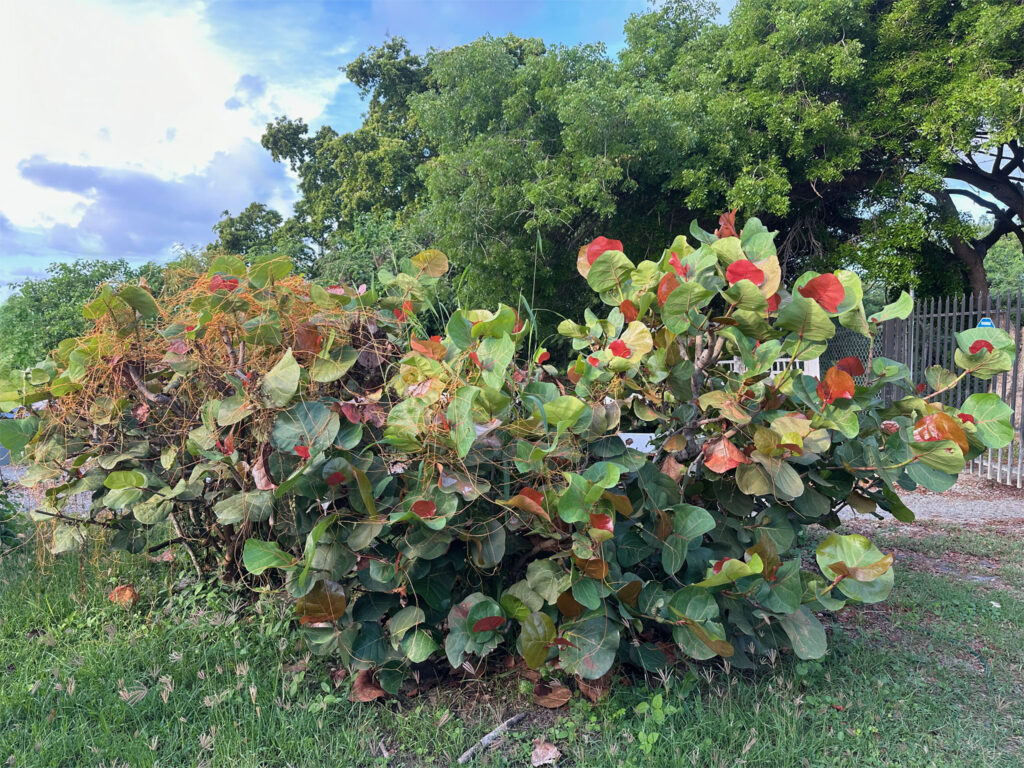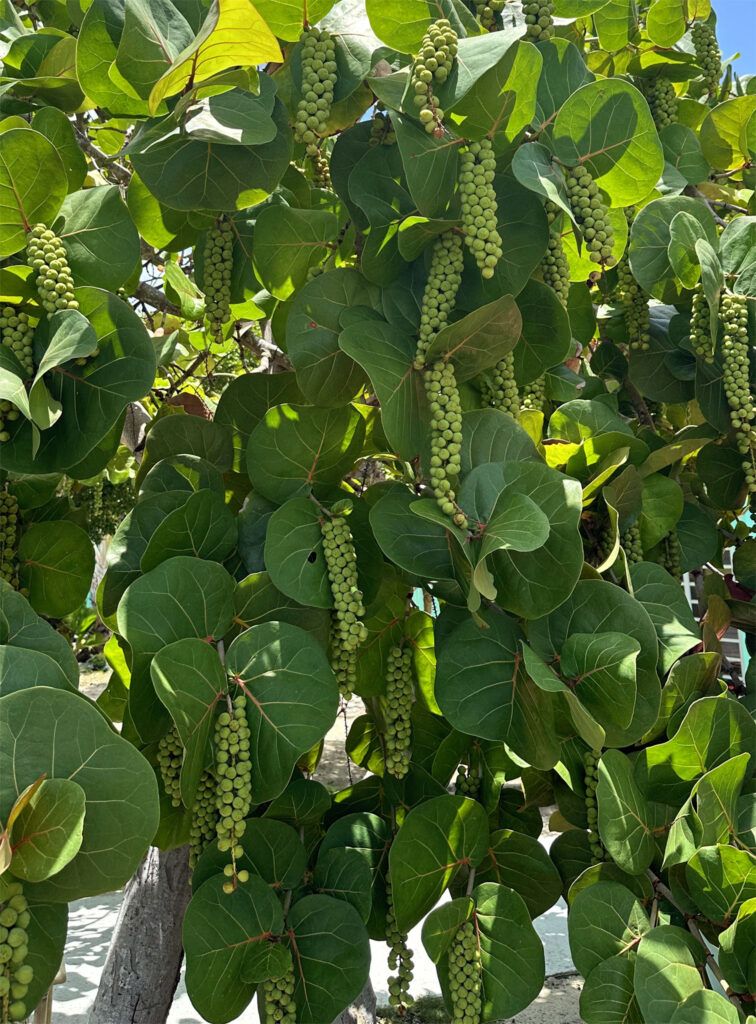Scientific name: Coccoloba uvifera
Common names: Sea Grape, Bay Grape, Shore Grape, Uva de Playa (Spanish for “beach grape”), Seaside Grape
The Sea Grape is an integral part of St. Croix’s natural and cultural heritage. Its presence along the coastline not only enhances the island’s beauty but also plays a vital role in protecting and sustaining the local environment. This evergreen shrub or small tree is well-known for its large, round leaves and clusters of grape-like fruit. On St. Croix, the Sea Grape serves not only as an important ecological component but also as a cherished part of the local culture and landscape. Conservation efforts are essential to ensure that future generations can continue to enjoy and benefit from this remarkable plant. Whether you are a local resident or a visitor, taking the time to appreciate and support the Sea Grape is a meaningful way to connect with the island’s rich natural landscape.
The Sea Grape can grow up to 30 feet tall, though it often appears as a sprawling shrub in coastal areas. Its leaves are large, leathery, and nearly circular, often with red veins. The plant produces small, white flowers that develop into green fruit, which turn a purplish-red when ripe. The fruit resembles clusters of grapes, each containing a single large seed. When ripe, the fruit is sweet and edible, often used in jellies, preserves, and drinks. Sea Grape thrives in sandy soils and is commonly found along beaches and coastal dunes, where it helps stabilize the shoreline and prevent erosion.
The fruit of the Sea Grape has been used by the indigenous people and locals for centuries. It is commonly made into jellies, jams, and beverages. The leaves have been used in traditional crafts and as natural wraps for food and it is a popular plant in landscaping due to its hardiness and ornamental value. Its ability to withstand salt spray and wind makes it ideal for coastal gardens.
Despite its resilience, Sea Grape faces threats from coastal development, pollution, and climate change. Construction along coastlines can disrupt its natural habitat and lead to increased erosion. Efforts to protect and restore Sea Grape populations include planting projects and regulations to limit coastal development. Community awareness programs help educate the public on the importance of this plant to the island’s ecology and culture.

Medicinal uses:
The Sea Grape, native to coastal regions such as St. Croix in the US Virgin Islands, has a variety of traditional medicinal uses. While it is primarily known for its ecological and culinary benefits, different parts of the plant have been used in folk medicine. Here are some of the medicinal uses attributed to the Sea Grape:
The leaves and bark of the Sea Grape plant have been traditionally used for their antibacterial properties. Decoctions made from the leaves and bark are sometimes used to wash wounds and sores to prevent infections.
The ripe fruit of the Sea Grape is sometimes consumed to aid digestion. It is believed to have mild laxative properties, helping to relieve constipation.
Leaf extracts are used in some traditional practices to reduce inflammation. Poultices made from the leaves can be applied to inflamed skin or used to alleviate pain from insect bites and stings.
The bark and leaves of the Sea Grape have astringent qualities. Decoctions or infusions are used as gargles or mouth rinses to treat sore throats and mouth ulcers.
The bark of the Sea Grape tree is sometimes used to prepare a diuretic tea. This tea is consumed to promote urine production and help with conditions such as urinary tract infections and edema.
Traditional medicine often employs the bark and leaves to treat dysentery. Infusions made from these parts of the plant are taken internally to help alleviate symptoms of this gastrointestinal disorder.
Poultices made from Sea Grape leaves are applied to the skin to treat conditions like eczema, rashes, and minor burns. The soothing properties of the leaves help reduce itching and promote healing.
Preparation Methods:
- Decoction: Boiling the bark or leaves in water to extract their medicinal properties.
- Infusion: Steeping the leaves or bark in hot water to make a tea.
- Poultice: Crushing the leaves and applying them directly to the skin.
- Gargle/Mouth Rinse: Using decoctions as a rinse for oral health.

